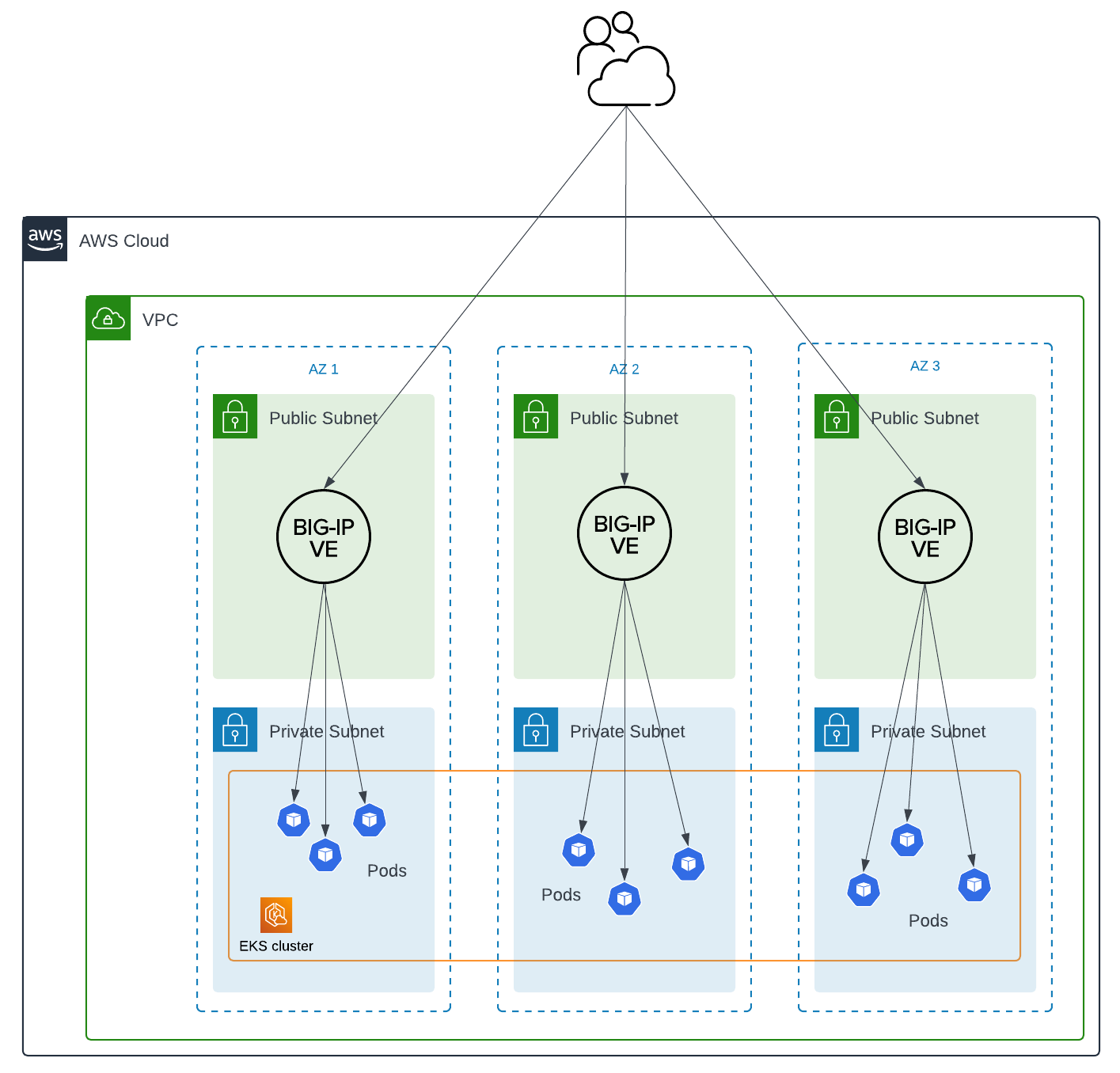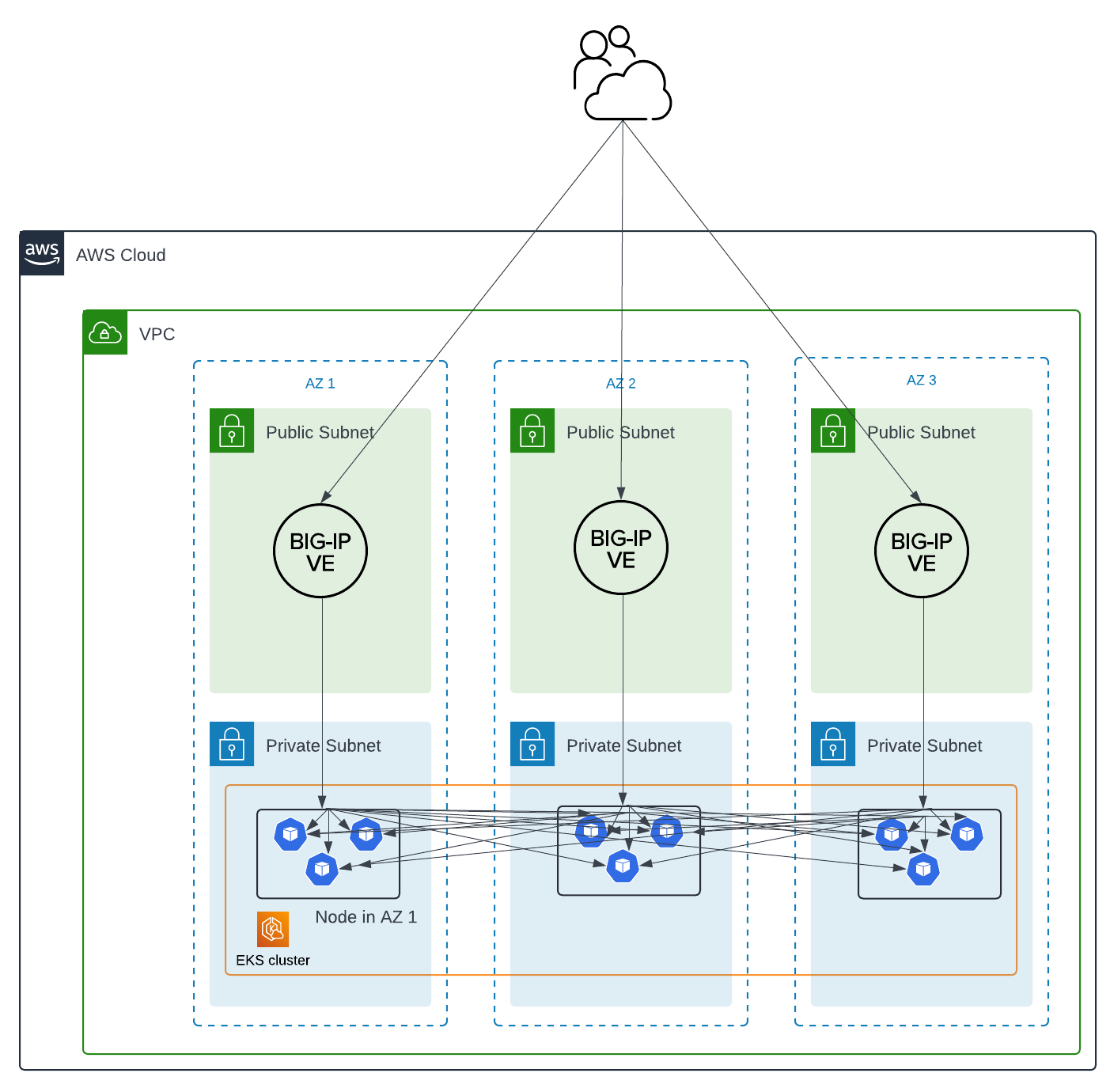Use topology labels to reduce cross-AZ ingress traffic with F5 CIS and EKS
Requirements and background
Recently I had a customer with the following environment:
- the need to load-balance traffic from Internet-based clients into EKS
- the need for mTLS termination and other functionality that required BIG-IP
- AWS EKS cluster deployed in 3x Availability Zones (AZ’s)
Simple enough, right? But there’s some other problems that add an interesting twist to the requirements:
- reduce or eliminate cross-AZ traffic between any external load balancer and EKS (due to cost of cross-AZ traffic)
- do not use NLB if possible (NLB throughput cost is significant)
- while mTLS/other functionality could be performed inside the cluster (eg NGINX Ingress Controller), we want these functions performed external to the cluster (for “business” reasons)1
Let’s solve this!
F5 CIS with a typical, default installation
Typically, a customer will use F5 CIS to dynamically update the configuration of an HA pair of BIG-IP’s, sending traffic directly to pods running inside Kubernetes (K8s).

Cross-AZ traffic with a typical CIS deployment
The above diagram is a valid deployment, but cross-AZ traffic is very likely. The BIG-IP’s are unaware of K8s topology, and will load-balance equally across AZ’s.
- Since only 1x BIG-IP is active in the pair, ingressing to pods in 2 out of 3 AZ’s requires cross-AZ traffic
- Ingress to pods in AZ 3 will always generate cross-AZ traffic, regardless of which BIG-IP is active
Multiple active BIG-IP’s and the node-label-selector argument with CIS
CIS can use the node-label-selector argument to limit load-balancing to select nodes. We will use this to keep ingress traffic local to an AZ.
To deploy an architecture like the following diagram:
- Find or create your topology labels. In my example using EKS, I see my nodes have labels such as
topology.kubernetes.io/zone=us-east-1a- You can also create your own labels on nodes for this purpose
- Deploy 3x standalone BIG-IP’s
- Deploy 3x CIS instances
- Use the
node-label-selectorargument so that each CIS instance only watches for pods on select nodes
- Use the

Here is an example of a CIS deployment with a node-label-selector (line 32):
1
2
3
4
5
6
7
8
9
10
11
12
13
14
15
16
17
18
19
20
21
22
23
24
25
26
27
28
29
30
31
32
33
34
35
36
37
38
39
40
41
42
43
44
45
46
apiVersion: apps/v1
kind: Deployment
metadata:
name: f5cis1
namespace: kube-system
spec:
replicas: 1
selector:
matchLabels:
app: k8s-bigip-ctlr-deployment
template:
metadata:
labels:
app: k8s-bigip-ctlr-deployment
spec:
containers:
- name: k8s-bigip-ctlr
image: "f5networks/k8s-bigip-ctlr:2.16.1"
env:
- name: BIGIP_USERNAME
valueFrom:
secretKeyRef:
name: bigip-login
key: username
- name: BIGIP_PASSWORD
valueFrom:
secretKeyRef:
name: bigip-login
key: password
command: ["/app/bin/k8s-bigip-ctlr"]
args: [
"--node-label-selector=topology.kubernetes.io/zone=us-east-1a",
"--bigip-username=$(BIGIP_USERNAME)",
"--bigip-password=$(BIGIP_PASSWORD)",
"--bigip-url=10.0.0.11",
"--bigip-partition=kubernetes",
"--pool-member-type=cluster",
"--insecure",
"--custom-resource-mode=true",
"--log-level=DEBUG",
"--disable-teems=true"
]
serviceAccount: bigip-ctlr
serviceAccountName: bigip-ctlr
imagePullSecrets:
- name: bigip-login
Other pointers in this solution
- NLB’s are not required. To avoid NLB throughput costs, use DNS Load Balancing (GSLB) to spread traffic evenly across your Internet-facing BIG-IP’s. Other methods to disaggregate traffic exist also but are not the focus of this solution.
- This solution does not require the K8s service to include any annotations, such as
service.kubernetes.io/topology-mode. This solution assumes that the K8s pods are randomly spread across AZ’s within a single service.
NodePort vs Cluster mode
It is worth noting that the diagrams above have assumed the CIS deployment is in ClusterIP mode, and not NodePort mode. If you were sending traffic to K8s nodes and relying on kube-proxy to distribute traffic evenly across pods, you would almost certainly generate cross-AZ traffc between nodes.


Further reading about topology and routing in K8s
Topology Aware Routing is a K8s concept that uses labels and annotations to allow an administrator to define preferences for keeping traffic within regions or zones where possible. This solution does not take full advantage of this concept, but merely uses these labels to limit which pods CIS will configure on BIG-IP. Today, CIS and BIG-IP are not fully aware of the Kubernetes topology in which they operate.
It is worth noting the AWS EKS Best Practices Guide, specifically as it discusses AWS Load balancers. When you use AWS ALB or NLB, you can choose between instance mode (somewhat similar to the NodePort example above) and ip mode (similar to the ClusterIP example above). If you’re planning to do something similar to what I’ve done above using AWS native load balancers, make sure you understand the difference and configure accordingly.
Finally, the above solution does not apply only to AWS EKS. The concept of regions and zones exists in most clouds, and the concept of topologies in Kubernetes were created to account for these. However, it’s the cross-AZ traffic charges in AWS that make this solution pressing for users of AWS EKS.
Summary
Consider if your external load balancer is causing cross-AZ traffic charges for ingress traffic. If using F5 CIS to populate pods as pool members in BIG-IP, consider using the node-label-selector argument and multiple active BIG-IP’s to keep ingress traffic to pods within a single Availability Zone.
Footnotes
-
The reasons in this case aren’t important, but it’s not uncommon for this kind of thing to be based on skillsets, other projects, preferred vendors, or the internal political landscape. ↩